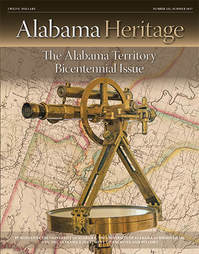
The Summer 2017 issue of Alabama Heritage magazine features expanded articles, a pullout map, and a detailed foldout timeline that highlight Alabama becoming a territory, and is published in conjunction with the launching of Alabama 200, a three-year-long celebration of the Alabama Bicentennial Commemoration.
This packed issue contains more editorial content with almost 30 pages of additional articles by state historians and award-winning authors.
This packed issue contains more editorial content with almost 30 pages of additional articles by state historians and award-winning authors.
Some of the features include “A Long Road to Becoming a Territory” by Edwin C. Bridges, former director of the Alabama Department of Archives and History. By the time Alabama became its own territory 200 years ago, it already had witnessed enough history to fill textbooks. Historian Mike Bunn details how the Mississippi-Alabama border was well-debated and became “more or less arbitrary.” Historian George Shorter takes a look at Alabama’s first capital, located in St. Stephens, was once a thriving town during the territorial era and is now a historical park.
Award-winning author John Hall, who recently passed away after writing this final article for Alabama Heritage magazine, is joined by his wife Rosa Hall in the feature “The Three Sisters.” The Halls explain how squash, beans, and corn provided Indians in the Southeast a hearty, nutrient-rich diet. Eventually, these foods, along with other traditional Native American food sources, would become part of the traditional southern diet as well.
Other features include stories on land claims and surveying in the Alabama territory, the varied peoples and cultures that helped shape the territory during its brief transition to statehood, and the migrations to the wilderness of early Alabama during Alabama Fever.
Departments include a letter from Alabama Sen. Arthur Orr, a dedication to naturalist John C. Hall, and a Quarter-by-Quarter review of the Alabama Territory, beginning with the Spring to Summer of 1817.
Alabama Heritage, celebrating more than 30 years of fine publishing, is co-published by the University of Alabama, the University of Alabama at Birmingham, and the Alabama Department of Archives and History. The quarterly magazine covers a variety of subjects related to Alabama history and culture, and has garnered numerous local, regional, and national awards over the years. Copies are available for purchase at the University of Alabama Supply Store, at Barnes & Nobles and Books-a-Millions throughout the state, and online at www.alabamaheritage.com. Readers can also follow the magazine on Facebook, Twitter, Pinterest, Instagram, Google+, and YouTube.
Award-winning author John Hall, who recently passed away after writing this final article for Alabama Heritage magazine, is joined by his wife Rosa Hall in the feature “The Three Sisters.” The Halls explain how squash, beans, and corn provided Indians in the Southeast a hearty, nutrient-rich diet. Eventually, these foods, along with other traditional Native American food sources, would become part of the traditional southern diet as well.
Other features include stories on land claims and surveying in the Alabama territory, the varied peoples and cultures that helped shape the territory during its brief transition to statehood, and the migrations to the wilderness of early Alabama during Alabama Fever.
Departments include a letter from Alabama Sen. Arthur Orr, a dedication to naturalist John C. Hall, and a Quarter-by-Quarter review of the Alabama Territory, beginning with the Spring to Summer of 1817.
Alabama Heritage, celebrating more than 30 years of fine publishing, is co-published by the University of Alabama, the University of Alabama at Birmingham, and the Alabama Department of Archives and History. The quarterly magazine covers a variety of subjects related to Alabama history and culture, and has garnered numerous local, regional, and national awards over the years. Copies are available for purchase at the University of Alabama Supply Store, at Barnes & Nobles and Books-a-Millions throughout the state, and online at www.alabamaheritage.com. Readers can also follow the magazine on Facebook, Twitter, Pinterest, Instagram, Google+, and YouTube.
